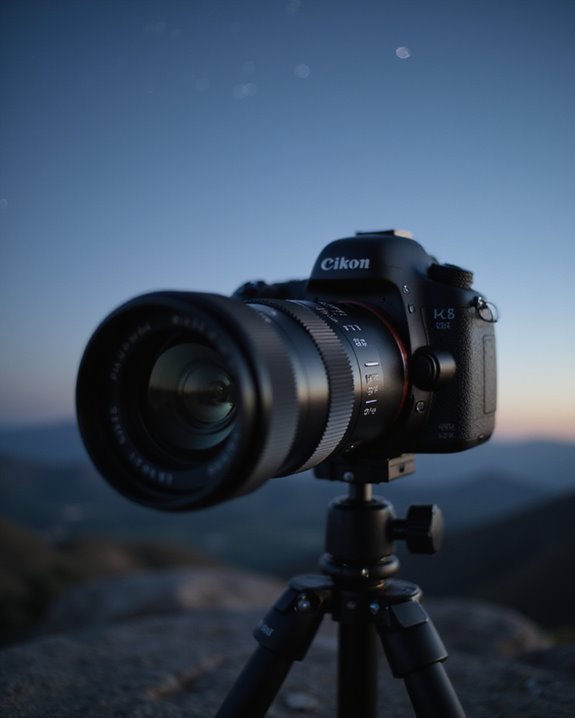A macro camera lens is a specialized photographic tool designed to capture extreme close-up images at life-sized (1:1) magnification or greater. These precision optics reveal intricate details invisible to the naked eye while maintaining exceptional sharpness at close distances. Available in various focal lengths (typically 50-200mm), macro lenses provide working distances appropriate for different subjects like insects, flowers, or product details. The distinctive flat field focus and specialized elements minimize distortion, making these versatile instruments essential for photographers seeking to explore the miniature world.
Key Takeaways
- A macro camera lens achieves 1:1 magnification ratio or greater, producing life-sized images of small subjects on the camera sensor.
- These specialized lenses maintain exceptional sharpness at close distances while revealing details invisible to the naked eye.
- Macro lenses come in various focal lengths (60mm to 200mm), with longer ones providing greater working distance for subjects like insects.
- They’re designed as prime lenses with flat field focus, specialized optics, and often image stabilization to maximize sharpness.
- Popular applications include nature photography, product documentation, scientific research, jewelry showcasing, and collectible authentication.
Second-Level Headings for “What Is A Macro Camera Lens”
What exactly defines a macro camera lens, and how does it differ from standard photography equipment? Macro lenses feature specialized optics designed to reproduce life-sized (1:1 magnification) images on camera sensors, allowing photographers to capture extreme close-up details invisible to the naked eye. Unlike regular lenses, true macro lenses maintain exceptional sharpness and resolution at close focusing distances, with minimum object distances typically ranging from 20-30cm depending on focal length.
These specialized lenses come in various focal lengths, from shorter, budget-friendly options to telephoto designs that provide greater working distance for skittish subjects like insects. Regular Lens Maintenance is critical for preserving optical performance, especially since macro work often involves dusty outdoor environments. Future Innovations in this field continue to explore extended magnification ratios beyond 1:1, with some specialty lenses now achieving 2:1 reproduction for even more detailed macro photography.
Defining the Macro Lens: Magnification and Purpose
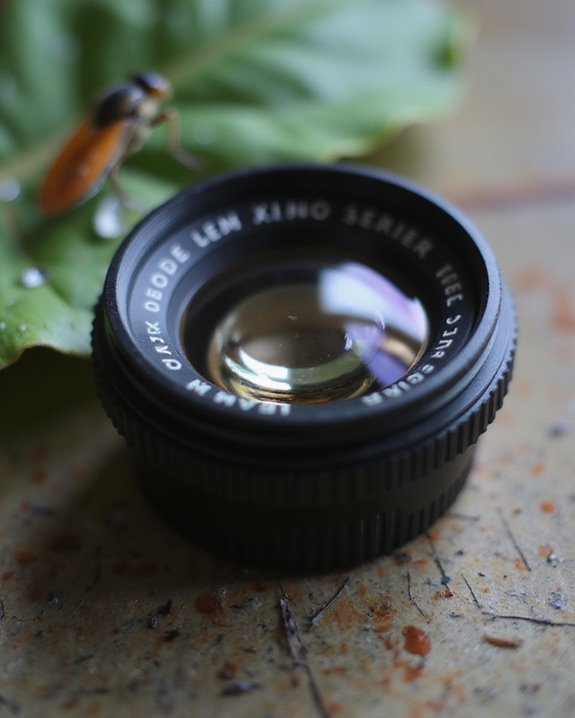
A macro lens stands distinct in the photography world through its defining characteristic: the ability to achieve 1:1 magnification ratio or greater. This specification means the subject appears on the camera sensor at life-size or larger, enabling photographers to capture intricate details invisible to the naked eye. Lens Evolution has expanded the capabilities of macro photography while maintaining this fundamental criterion. True macro lenses consistently offer extremely close minimum focusing distances and exceptional image quality. These specialized optics serve primarily for close-up photography of small subjects like insects, flowers, and product details. The prime lens design of most macro lenses guarantees superior resolution and smooth bokeh, making them invaluable tools for photographers seeking to reveal hidden dimensions of everyday objects with precision and clarity.
Technical Specifications of Macro Lenses

The fundamental technical specifications of macro lenses establish their unique capabilities in the photography world, distinguishing them from standard lenses through specialized design parameters. These lenses typically achieve magnification ratios of 1:2 (half-size) or 1:1 (full-size), with specialized variants offering even higher magnifications up to 2:1. Working distances vary considerably based on focal length categories: short (35-60mm), midrange (80-105mm), and long (150-200mm). Many modern macro lenses feature image stabilization up to 5 stops, enabling sharper handheld macro photography in various lighting conditions. Advanced macro lenses often incorporate APO Design elements that minimize chromatic aberration while enhancing image quality and detail reproduction. Many modern models feature Stabilization Features, allowing photographers to capture crisp images handheld at slower shutter speeds. The construction typically remains slim and compact despite sophisticated optics, with most macro lenses designed as primes to guarantee maximum sharpness and the smooth bokeh backgrounds that macro photography demands.
Close-Up Photography: The Macro Advantage
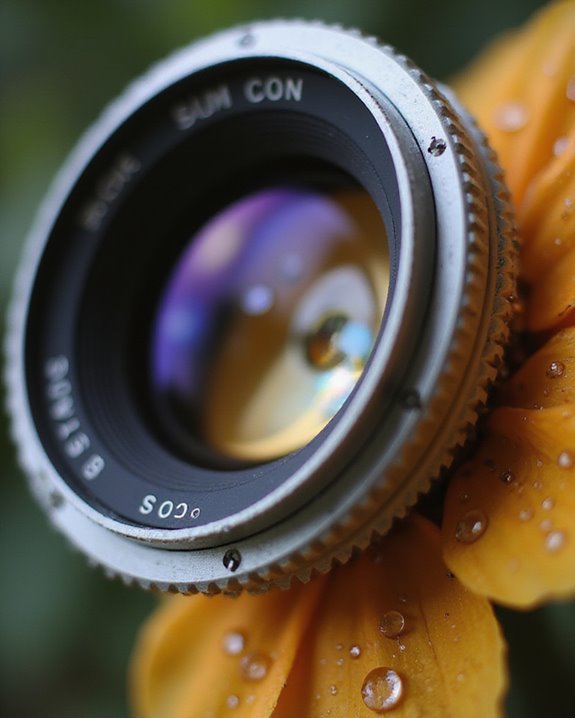
Close-up photography reveals an entirely new dimension of visual perception, pushing beyond the limitations of standard lenses to capture extraordinary detail in ordinary subjects. Macro lenses excel in this domain by offering a substantially shorter minimum object distance, allowing photographers to achieve life-size (1:1) or half-life-size (1:2) magnifications with exceptional clarity across the frame.
The true advantage of macro lenses lies in their ability to transform the mundane into the magnificent, though not without challenges. Lighting challenges often emerge as subjects are approached closely, requiring specialized diffusers or ring lights to prevent harsh shadows. Stability issues become paramount at high magnifications, where even minor vibrations can blur details, necessitating tripods or image stabilization technology. Despite these hurdles, macro lenses reveal microscopic worlds otherwise invisible to the naked eye.
Popular Macro Lens Options on the Market
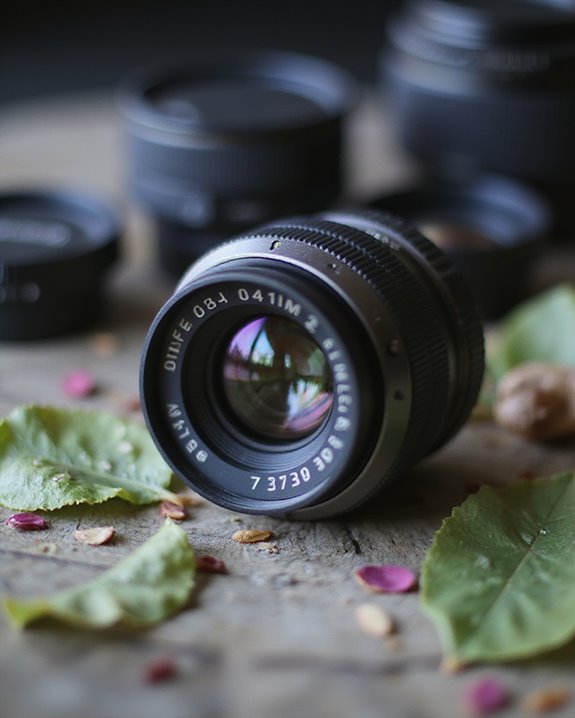
Today’s photographers can choose from an extensive array of macro lenses, each offering unique advantages for close-up image creation. Canon’s EF 100mm f/2.8 USM and Sony’s FE 90mm f/2.8 Macro G OSS stand as industry standards, providing 1:1 magnification with built-in stabilization systems, reflecting decades of Lens Innovation History since early close-up photography developments in the 1950s.
For specialized applications, Venus Laowa’s distinctive offerings include the waterproof 24mm f/14 Probe lens with LED illumination and their 25mm f/2.8 Ultra Macro with 2.5-5X magnification capabilities. Lens Pricing varies greatly across manufacturers, with professional-grade options from Canon and Sony commanding premium prices, while third-party manufacturers like Tamron and Sigma provide more affordable alternatives without sacrificing essential features like weather sealing and optical quality.
Choosing the Right Macro Lens for Your Needs
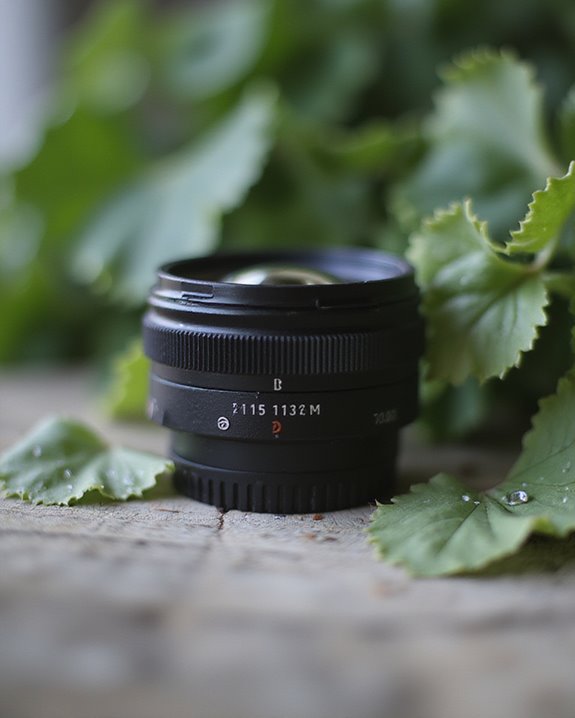
Selecting an appropriate macro lens begins with understanding how different specifications affect real-world performance for close-up photography. Focal length primarily determines working distance, with longer lenses (150-200mm) providing comfortable spacing for skittish subjects, while shorter options (40-60mm) excel in controlled studio environments. Budget options under $500 typically sacrifice weather sealing or image stabilization but maintain true 1:1 magnification capabilities.
When evaluating ergonomic features, photographers should consider lens weight, internal focusing mechanisms, and filter compatibility. Heavier tele-macros often include tripod collars for stability, while lightweight 50mm designs permit extended handheld shooting. Subject matter heavily influences selection: product photographers benefit from flat-field 60mm options, while insect specialists require 100mm+ focal lengths to maintain distance without disturbing subjects. Additionally, advanced macro features from third-party options and adapters can enhance versatility and image quality for various shooting scenarios.
Mastering Macro Photography Techniques
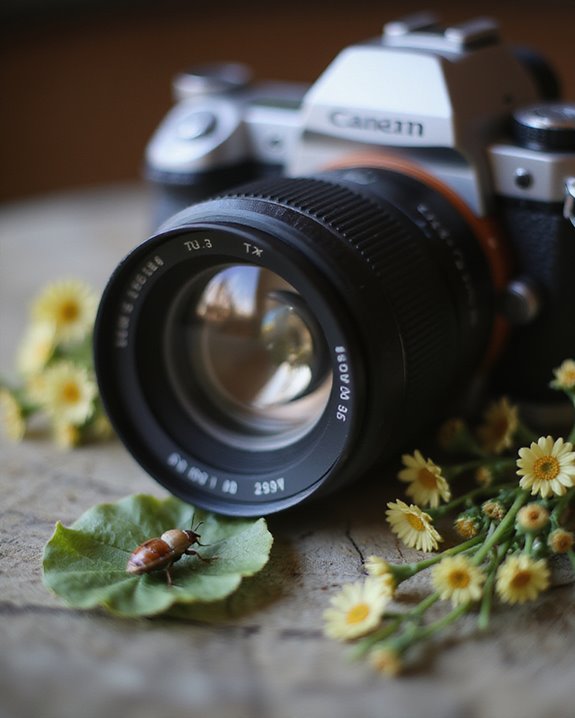
Mastering the techniques of macro photography requires a thorough understanding of specialized focusing methods and careful attention to camera settings that dramatically differ from standard photography approaches. Manual focusing becomes essential at high magnifications, as autofocus systems often struggle with the extremely shallow depth of field characteristic of macro work. Photographers frequently employ Focus Stacking, merging multiple images taken at different focus points to achieve greater overall sharpness.
Lighting presents unique challenges in macro photography, with Diffused Lighting being essential for revealing intricate textures without harsh shadows. Ring lights and LED panels provide even illumination, while reflectors help balance exposure in shadowed areas. Camera stability remains paramount, typically requiring tripods to prevent vibration, alongside ideal aperture settings (f/8-f/16) that balance depth of field with image quality considerations.
Common Applications and Subject Matter for Macro Lenses
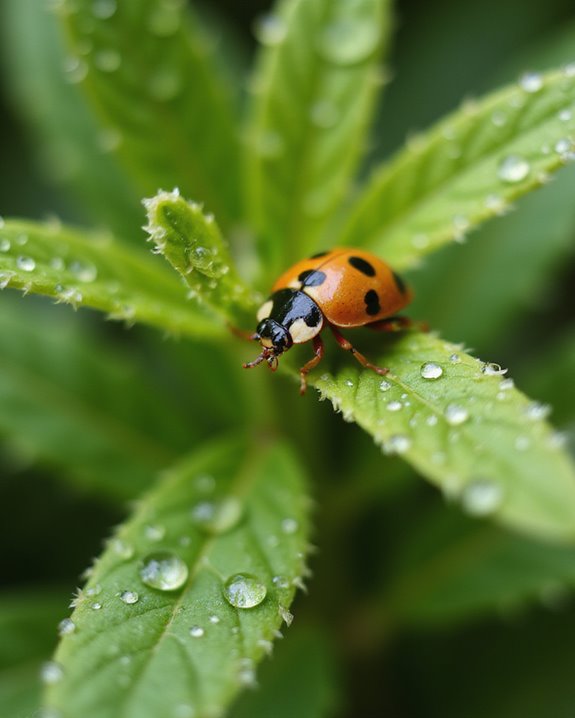
Macro lenses excel across a diverse range of photographic applications, making them exceptionally versatile tools for capturing the minute details often invisible to the naked eye. In Nature Exploration, these specialized lenses reveal intricate textures of flower petals, delicate insect features, and the hidden patterns of plant anatomy with remarkable clarity. Professional product photographers utilize macro lenses to showcase the fine craftsmanship of jewelry, watches, and small electronics, highlighting details that distinguish premium products.
For Collectible Cataloging, macro photography provides essential documentation of coins, stamps, and other valuable items, preserving their condition and authenticating distinctive characteristics. Beyond these common uses, macro lenses serve scientific research, food photography, and architectural documentation, where their technical features—1:1 magnification, flat field focus, and high sharpness—deliver consistently superior results.
Frequently Asked Questions
Can Macro Lenses Be Used for Portrait or Landscape Photography?
Yes, macro lenses excel in both portrait and landscape photography. Their exceptional sharpness captures flattering portrait bokeh despite some aperture limitations, while their edge-to-edge clarity reveals intricate landscape details with minimal distortion.
How Do Macro Lenses Perform in Low-Light Shooting Conditions?
Macro lenses often struggle in low-light conditions due to light gathering limitations at higher magnifications. Image stabilization features help compensate, but photographers typically need to use tripods or additional lighting for best results.
Are Macro Lens Filters Necessary for Better Results?
Macro lens filters aren’t necessary for quality results. While they offer cost-effective magnification, high filter quality and proper filter maintenance are essential when used. Dedicated macro lenses typically deliver superior outcomes without additional accessories.
Can Smartphone Attachments Replace Dedicated Macro Lenses Effectively?
Verily, smartphone attachments cannot fully replace dedicated macro lenses. While offering versatility and convenience, they typically lack the optical quality, attachment durability, and professional capabilities that serious macro photographers require for consistent, high-quality results.
How Does Focus Stacking Enhance Macro Photography Results?
Focus stacking enhances macro photography by combining multiple images to extend depth of field. Stacking techniques overcome inherent limitations, while software options like Helicon Focus and Photoshop automate the merging process for sharper results.


